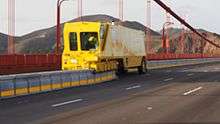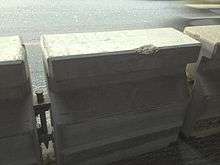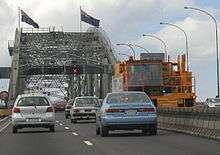Barrier transfer machine



Barrier transfer machines, also known as zipper machines or road zipper, are heavy vehicles used to transfer concrete lane dividers, such as jersey barriers, which are used to relieve traffic congestion during rush hours. Many other cities use them temporarily during construction work.[2][3][4] The lanes created by the machine are sometimes referred to as zipper lanes.[5]
One advantage of barrier systems over other lane management treatments (i.e.: cones, overhead directional lights) is that a solid, positive barrier prevents vehicle collisions due to motorists crossing over into opposing traffic flow.[6][7] A disadvantage is that lane widths can be slightly reduced.[7]
Operation
The vehicle contains an S-shaped, inverted conveyor channel in its undercarriage which lifts the barrier segments (which may weigh over 1,000 pounds (454 kg)) off the road surface and transfers them over to the other side of the lane, reallocating traffic lanes to accommodate increased traffic for the currently dominant (peak) direction These barriers are linked together with steel connectors to create a sturdy but flexible safety barrier.[5][8]
The minimum length for some barrier systems is 100 feet (30 meters). The length can vary based on application and the amount of barrier needed to effectively deflect an errant vehicle.[9]
Some barrier systems have four rubber feet on the bottom of each segment “to increase the coefficient of friction between the barrier element and the road surface”. This helps the barrier resist vehicle impact and keeps the barrier from moving significantly when struck.[9]
Barrier transfer machines can typically move their barrier segments anywhere between 4 and 24 feet in one pass, usually at a speed between 5 and 10 mph. Some models of the machine hold 50 feet (15 meters) of barrier at a time as they are engaged in transferring.[2][3][4][5][6] The machine can transfer within the regular traffic flow without hindering other vehicles:
“Admirably engineered, the barrier-moving process does not compromise traffic flow in either direction, and the truck is shielded by the blocks it's moving. If you're traveling in the same direction as the truck, the lane it's working behind is already blocked. And if you pass the vehicle at the speed limit, you can safely move into the lane ahead of it. Oncoming motorists, meanwhile, are prevented from entering the zipper's lane by the concrete barriers in front of it, and they can move into a lane after they have passed the truck.” --Ann L. Rappoport, Philly.com[10]
Upon completing its pass, some barrier transfer machines can be moved across outside traffic lanes away from the area. However, other systems simply park in a median between their movable barrier and an affixed barrier to keep them from impeding traffic flow.[2][11] A barrier transfer machine that operates outside of Honolulu has its own garage in the space between viaducts.[5]
Permanent Locations
Moveable barriers are in permanent use in such cities as Auckland (Auckland Harbour Bridge[7]); Montreal, Quebec; Philadelphia, Pennsylvania;[12][13] the New York metropolitan area[12] (notably the Tappan Zee Bridge and the western portion of the Long Island Expressway); Honolulu, Hawaii[5]]; San Juan, Puerto Rico; Boston, Massachusetts (for the Southeast Expressway); Washington, DC; Dallas, Texas; San Francisco[12] (on the Golden Gate Bridge and Presidio Parkway); San Diego, California; and Sydney, New South Wales.
Variants
The Road Zipper brand movable barrier model is one vehicle, piloted by two operators located at opposite ends of it, typically at a 25 degree angle (the “crab angle”[11]) along the barrier. Sophisticated models can be customized for their application and local road characteristics (grades, curves, etc.). Hydraulically adjustable units and computerized steering guidance systems in such models further aid in accurate transfer vehicle movement and barrier placement.[5] Permanent, sophisticated units can cost around US $1 million each.[5][10]
Another variant of the machine uses two narrower machines running in tandem. This setup tends to be used in reversible lanes (also known as contraflow lanes) when the movable barrier is used to divide two directions of traffic—the narrower machines are less of an impediment to traffic in either direction.
History
- The Road Zipper variant has been in existence since 1984-1985.[7][10][12]
- Auckland Harbor Bridge had its original moveable barrier system installed in 1990[7]
- The Hawaii Department of Transportation debuted a Zipper Lane (“ZipLane”) on Oahu on August 18, 1998. A local radio station van was the first vehicle to enter:[5]
"The first vehicle to enter the ZipLane on its opening day was the KSSK Prize Van. As Be-Jay Kodama drove and D. J. Jim Erickson filed reports with on-air personalities Perry & Price, the voice of Sweetie Pacarro was heard singing 'Zippity Do Dah' in the background. Then a listener called to ask Perry & Price to speed up the van. Seems the woman caller was behind the van in the ZipLane. She was heading for the hospital and her water had just broken. Ah yes, 'Life in the fast Lane' …"[5]
- The Ben Franklin Bridge has had a permanent barrier transfer system since the year 2000, when it was installed by the Delaware River Port Authority.[10][13]
- A moveable barrier system was introduced in Sydney, NSW, Australia, in 2012.[7]
- The Golden Gate Bridge had a permanent 13,340-foot movable barrier system installed in January 2015.[14][15]
See also
- Reversible lane
- http://www.barriersystemsinc.com/applications
- http://www.highwaycare.co.uk/product_info/6/quickchange-moveable-barrier
- http://goldengatebridge.org/projects/MoveableMedianBarrier.php
References
- ↑ "Moveable Concrete Barrier" (PDF). p. 7. Archived from the original (PDF) on 14 May 2013. Retrieved 16 August 2014.
- 1 2 3 "Public Roads: Moveable Barrier Solves Work-Zone Dilemma". www.fhwa.dot.gov. July–August 2001. Retrieved 2016-06-14.
- 1 2 "Barrier Systems for Road Construction". www.barriersystemsinc.com. Retrieved 2016-06-14.
- 1 2 http://www.dot.state.mn.us/metro/projects/i494richfield/pdf/Moveable_Barrier.pdf
- 1 2 3 4 5 6 7 8 9 Papacostas, C. S. (2000). "HONOLULU'S ZIPPER LANE: A MOVEABLE BARRIER HOV APPLICATION" (PDF). University of Hawaii at Manoa.
- 1 2 "Moveable Barrier Systems for Bridges". www.barriersystemsinc.com. Retrieved 2016-06-14.
- 1 2 3 4 5 6 "Golden Gate Bridge gets Lindsay Transportation Solutions barrier". World Highways (Routes Du Monde). Route One Publishing LTD. Retrieved 14 June 2016.
- ↑ A zipper machine in action on I-95.
- 1 2 Technical Report. Barrier Systems Inc. TB 990901 Rev-1. p.1-2. Circa 2000.
- 1 2 3 4 "A barrier that's strangely moving". philly-archives. Retrieved 2016-06-14.
- 1 2 Ross, Jr., Hayes E. (May 1989). "EVALUATION OF MOVABLE BARRIER FOR SEPARATING CONTRAFLOW LANES FROM FREEWAY LANES" (PDF). State Department of Highways and Public Transportation, District 18, Dallas. Texas Transportation Institute, Texas A&M University. Retrieved 14 June 2016.
“Since the transfer vehicles cannot be safely and quickly driven on the freeway for any appreciable distance, it is highly desirable that provisions be made to store them in close proximity to the ends of the barrier. The preferable storage location would be in the median if space can be made available.”
- 1 2 3 4 "Fact Sheet". www.barriersystemsinc.com. Retrieved 2016-06-14.
- 1 2 "Ben Franklin Bridge to get new "zipper"". philly-archives. Retrieved 2016-06-14.
- ↑ "Movable median barrier coming to Golden Gate Bridge". SFGate. Retrieved 2016-06-14.
- ↑ "Golden Gate Bridge to close for installation of median barrier". ABC7 San Francisco. 2015-01-03. Retrieved 2016-06-14.